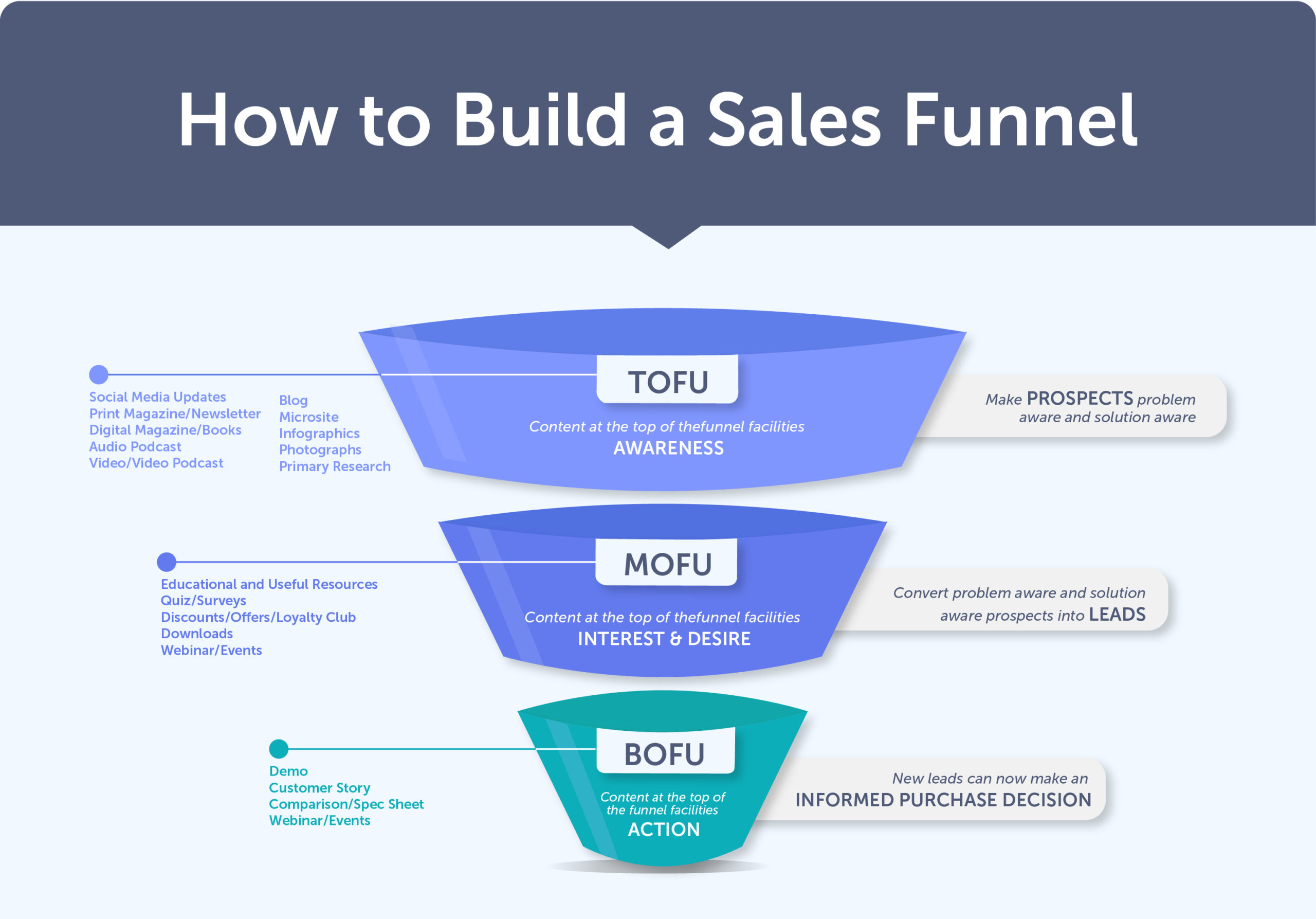Sales, by all accounts, is a perfect blend of art and science. A sales rep prospecting clients on the phone is pure art (that’s why some are good at it while others not so much) but deciding who to call is pure science (think CRMs and sales automation tools). That’s the core objective of a sales funnel- augmenting the art of selling with the power of sales technologies to create efficient sales pipelines.
What is a Sales Funnel and How Does it Work?
A sales funnel is a marketing concept that describes the journey a potential customer goes through from becoming aware of a product or service to making a purchase. The typical sales funnel has several stages, including awareness, interest, consideration, and purchase. At each stage, the customer is presented with different types of content or offers that are intended to move them closer to making a purchase. Sales funnels are used to track the progress of leads and customers, and to optimize the marketing and sales efforts to improve conversion rates.
Broadly speaking, a Sales Funnel is the umbrella term used for a buyer’s entire journey. From discovery to conversion to feedback, everything a sales and marketing team does to acquire and retain customers is collectively referred to as a Sales Funnel.

It is called a funnel because through each stage you qualify and filter your leads, improving the quality and focus with each step. Generally, a sales funnel progresses through 5 general stages:
- Awareness: The customers realize they have a problem and there is a solution to their problem
- Discovery: They realize your product can solve their problem
- Evaluation: They compare all the available options and do some cost-benefit analysis
- Intent: They are ready to buy but want a better deal
- Purchase: They sign the contract
In recent years, support and advocacy have also come to be recognized as essential parts of the sales funnel for their ability to drive word of mouth referrals and upsell/cross-sell conversations.
Generally, marketers are responsible for the Awareness and Discovery stages while salespeople handle the Intent and Purchase. The Evaluation stage is handled by both.
But keep in mind, while the traditional model of the sales funnel assumes that every customer goes through every step in order this is not necessarily true. Many customers now do all of the research on their own and move directly to the Intent stage. Similarly, someone leaving your Evaluation stage might move directly to the Intent stage. This is why it is important to have multiple sales funnels concurrently, each with their distinct stages to gain maximum traction.
Read About – Best Alternative to Zoominfo
How to Start With Sales Funnels
To start with sales funnels, you need to first understand your target audience and their needs. Next, you need to create a clear and specific goal for your sales funnel, such as increasing conversions or reducing cart abandonment. Then, you need to identify the different stages in your sales funnel, such as awareness, interest, consideration, and purchase. Once you’ve identified the stages, you need to create content and offers that are tailored to each stage and that will move the customer through the funnel towards the final goal. It’s also important to track and measure the performance of your sales funnel, so you can make data-driven decisions to optimize it for better results.
The Groundwork
Before you start creating a sales funnel, you must first build the infrastructure for identifying and engaging your prospects. This includes two key tasks:
Define your Ideal Customer Profile (ICP)
No matter what you sell, not everyone is going to buy it. Therefore, it is important that you clearly define who you are going to target based on metrics such as industry, location, company size, revenue, persona, etc. It is worth pointing out that the more specific ICPs you define, the more effective your sales funnel will be.
Create Content
Once you have defined who you are going to target, it’s time to determine how you want to be perceived. Your content, such as a website or landing page, is the first point of contact between you and your prospects. Your content creates the first impression and thus you must use this opportunity to your advantage.
While generic content (like the homepage of your website) can work for the entire funnel, it is always more effective to have distinct content for each stage and each of your ICPs. For example, if you are selling automation software for factories your content for each stage would look something like this:
- Awareness Stage: Focus on explaining the problems via content like “How automation software can improve efficiency and ROI”
- Discovery Stage: Distinguish your solution with content like “How XYZ is the best automation software on the market”
- Evaluation Stage: Use content to prove your claims via case studies or white papers like “How ABC used XYZ to improve productivity by 20%”
Once you have laid out the groundwork, it’s time to work on creating the sales funnel. So let’s get started:
Fill the Top of the Funnel
Ideally, the more people you put into the top of a funnel, the more qualified leads (and ultimately customers) you can expect to receive at the bottom. But while that’s applicable in theory, it doesn’t quite work out in the real-world due to two key factors: intelligence and data quality.
Most businesses just run generic social ads or buy email lists to run email campaigns to maximize their leads. While that puts a large number of people at the top of the funnel, they still get fewer qualified leads simply because most of the recipients don’t match their ICP. For instance, if you have a 2% clickthrough rate on your 10K emails of which 50% match your ICP, you will get only around 100 qualified leads. Even worse all of those unqualified leads create noise, distractions and are a drain on resources. So what is the solution?
Use Sales Intelligence
A better strategy would be to reach out to only those people that match your ICP. This can be achieved by adding a sales intelligence platform like SalesIntel to your marketing engine. This way, you can use technographic, firmographic, location, and intent data to build more precise target lists that conform to your ICP. In this case, if you send 10K emails with a 2% clickthrough rate, you will get double the number of qualified leads.
Get Accurate Data
Another problem is data quality. When businesses buy contact lists, it isn’t uncommon for over 25% of the emails to bounce. This again affects the effectiveness of a sales funnel and brings down the conversion rates. And things like high bounce rates and low engagement can threaten your ability to even send emails and have them land in people’s inboxes, jeopardizing your entire process
To take the earlier example, using both sales intelligence and accurate data for filling the top of the funnel can boost the number of leads by almost 250%.
Create a Sequence
Once you have launched your first campaign, you will begin seeing your prospects moving through the stages. Take email campaigns. Most people will not even open your mail, some will only read it, a few will click a link and visit your landing page, and finally, even fewer will fill out the request form. Depending on your product, pricing, etc., you should create a sequence of emails for each stage designed to nurture them and move them to the next step in the journey.
Additionally, as discussed earlier, prospects at each stage should be engaged using content appropriate for that stage. For instance, those not opening the mail should be sent awareness content while those visiting the site but not filling out a form should get evaluation content.
Analyze the Touchpoints
After your first cohort has completed a full journey through your funnel, the next task is to analyze how each of your stages performed. You should examine which content had more engagement and which ones failed to attract users or advance them to the next stage. Pay careful attention to stages where prospects are stalled or you are churning out a lot of leads that appear to be qualified. These lessons will help you tune your overall process and build better content around which you can optimize your sales funnel.
But some challenges are beyond prospecting and content. What if a customer finds your cost too high? Or they don’t currently need your product but might do in the future.
Offer a Freebie
In such cases where the price is a major contention or immediate conversion is not possible, offering a freebie can be a valuable next step. Be it a free trial, or a limited version of your product, offering a free solution can help you fill in the middle of your funnel that will in due time filter towards the bottom. After all, if a business likes using your free tool, they are more likely to be your paying customer in the future.
Example Tactics for Each Sales Funnel Stage
Consider a company called – TechSolutions Inc. The company has created a sales funnel for its cloud-based project management software. Here are some tactics they might use at each stage of the funnel:
Stage 1: Awareness
Objective: Help potential clients recognize their pain point(s) and that there is a solution available.
Tactics:
- Content Marketing:
Create blog posts, infographics, and videos highlighting common project management issues such as missed deadlines, budget overruns, and poor team collaboration.
- Social Media Marketing:
Share the content on platforms like LinkedIn and Twitter to reach project managers and business decision-makers.
- SEO (Search Engine Optimization):
Optimize website pages for keywords related to project management problems and solutions to attract organic search traffic.
Example:
TechSolutions Inc. publishes a blog post titled “5 Signs Your Project Management Process is Failing,” which outlines common issues faced by businesses and hints at the existence of solutions.
Stage 2: Discovery
Objective:
Guide potential clients to understand that TechSolutions Inc.’s product can solve their pain point(s).
Tactics:
- Webinars and Workshops:
Host events that demonstrate how the software can address specific project management challenges.
- Email Campaigns:
Send targeted emails to leads captured from content marketing efforts, showcasing how the software solves their problems.
- Case Studies:
Share success stories from current customers who faced similar challenges and overcame them using the software.
Example:
TechSolutions Inc. hosts a webinar titled “How Cloud-Based Solutions Can Revolutionize Your Project Management,” demonstrating the software’s capabilities and real-world applications.
Stage 3: Evaluation
Objective:
Help potential clients compare all available options and conduct a cost-benefit analysis.
Tactics:
- Product Demos:
Offer live and recorded product demonstrations tailored to the specific needs of different customer segments (industries, company sizes, etc.).
- Comparison Guides:
Create detailed guides comparing TechSolutions Inc.’s software with competitors, highlighting unique features and benefits.
- ROI Calculator:
Provide an online tool to help prospects calculate the return on investment (ROI) they can expect from using the software.
Example:
A potential client attends a personalized demo session where TechSolutions Inc. compares its software with three major competitors, highlighting superior features and cost-effectiveness.
Stage 4: Intent
Objective:
Encourage prospects who are ready to buy to finalize the purchase, often by offering a better deal.
Tactics:
- Special Offers:
Provide limited-time discounts, bundled packages, or additional services for free.
- Follow-up Communication:
Sales representatives reach out with personalized offers and address any last-minute concerns.
- Trial Extensions:
Offer an extension on free trials to give prospects more time to evaluate the software.
Example:
After showing strong interest, a prospect receives a call from a sales rep who offers a 15% discount on an annual subscription if they sign up within the next week.
Stage 5: Purchase
Objective:
Convert prospects into paying customers by closing the sale.
Tactics:
- Smooth Onboarding:
Ensure a seamless onboarding process with comprehensive guides and dedicated support teams.
- Flexible Payment Options:
Offer various payment plans (monthly, quarterly, annual) to accommodate different financial preferences.
- Contract Incentives:
Provide incentives for signing longer-term contracts, such as discounts or additional features.
Example:
After a smooth negotiation process, the prospect agrees to an annual contract and signs up, benefiting from a discount offered and a dedicated customer success manager to help with onboarding.
By following these tactics at each sales funnel stage, TechSolutions Inc. can effectively guide potential clients from initially realizing their pain point to becoming satisfied customers, ensuring a structured and efficient sales process.
Top of the Funnel Vs Bottom of the Funnel
Top of the funnel (TOFU) refers to the early stages of a sales funnel, where a customer is first becoming aware of a product or service and is gathering information. Bottom of the funnel (BOFU) refers to the later stages of a sales funnel, where the customer is close to making a purchase decision. The TOFU aims to generate leads, while the BOFU aims to convert leads into customers and retain existing customers.
Close the Deal
This is kind of self-explanatory. Reach out to all the people who have reached the Intent stage and push them towards Purchase. Offer some discounts if you have to, but make this transition as short as possible because if they leave, they’ll enter directly the Intent stage of your competitors.
Closing Remarks
To wrap up all that we have discussed, there are four basic ingredients to creating an effective sales funnel:
- Knowing who to target
- Having their detailed and correct information
- Quality content
- Art of selling
Miss any of the four and you are destined to get mediocre results. We at SalesIntel play a modest but crucial role in that process. Good data can do little if you have poor content or don’t even know who your customers are. But if you can take care of the other three factors, we can guarantee SalesIntel will be a major asset to your sales funnel and the overall marketing engine.
Request a demo to get started or download our free chrome extension to get free contacts.
Sales Funnel FAQs
Q. 1 – What distinguishes a sales funnel from a marketing funnel?
Ans. – A marketing funnel focuses on attracting and engaging potential customers, introducing them to the brand, and generating leads. A sales funnel takes these leads and guides them through the decision-making process toward purchasing. In essence, the marketing funnel builds awareness and interest while the sales funnel converts that interest into sales.
Q. 2 – Is managing a sales funnel part of marketing?
Ans. – It’s a bit of both. At the top of the sales funnel, the marketing team works to turn visitors into leads and leads into prospects. As prospects move further down the funnel, the sales team takes over to close the deal. At the bottom, the marketing team re-engages to maintain the interest of existing customers and encourage repeat business.
Q.3 – Who should use a sales funnel?
Ans. – Every business should utilize a sales funnel since all businesses have customers. Sales funnels are valuable for companies of all sizes and industries, as they help manage and streamline the customer journey from interest to purchase.
Q.4 – Do sales funnels actually work?
Ans. – Think of a sales funnel as a method for attentively guiding your customer through their buying journey. Since understanding and catering to your customer’s needs is crucial, a well-constructed sales funnel can be very effective. Additionally, it helps you make the most of your marketing budget by optimizing resource allocation.
Q.5 – When might a sales funnel fail?
Ans. – A sales funnel can fail if it’s not designed or implemented correctly. Without clear goals, precise targeting, and engaging content, it may not attract enough prospects or keep them engaged throughout the process.
Q.6 – What is sales funnel leakage?
Ans. – Sales funnel leakage occurs when prospects and leads exit the funnel before becoming paying customers. This usually happens if the marketing team fails to engage them with relevant, exciting content, outreach efforts, offers, and other external factors such as pricing, better deals, etc.




